



|

|

|
During a total eclipse, the moon completely blocks out the solar disk. What you see is the corona (which means 'crown'), the Sun's outer atmosphere. It's very difficult to see the corona normally because the visible light from the solar surface, the photosphere, is a million times brighter than the light from the corona.
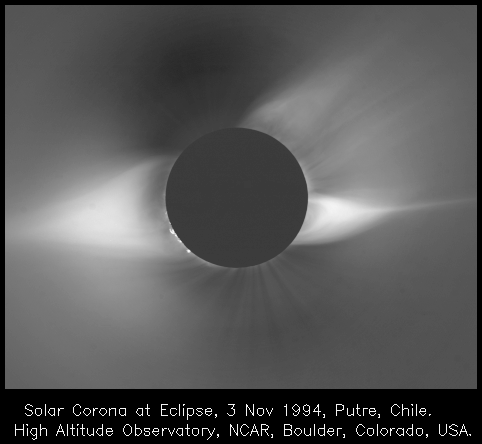
Although the photosphere is a cool 6000 C, the corona is very, very hot - over 1,000,000 C! This problem has puzzled solar physicists for more than 50 years. There are several theories as to why this should be so, none yet fully satisfactory. The corona could be heated by waves travelling up from the photosphere. We know that the magnetic field plays an important role, so changes in the magnetic field could transfer magnetic energy into thermal (heat) energy.
If you look at the Sun in X-ray emission you see only the plasma (ionised gas) at above one million degrees. You can clearly see the structure of the magnetic field.
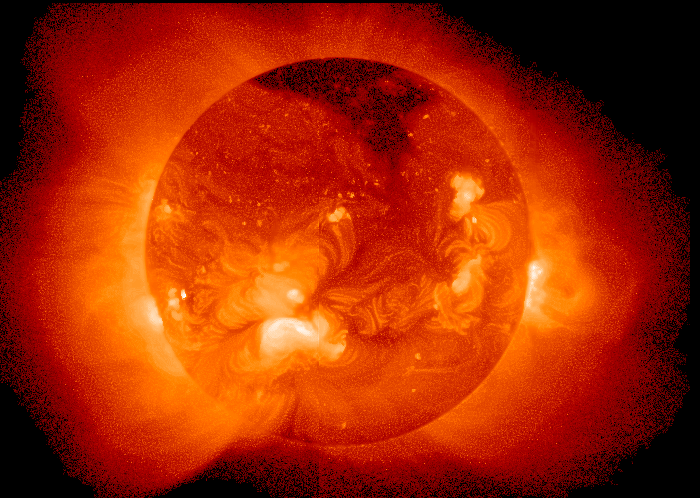
X-ray image from the Soft X-ray Telescope on YOHKOH, a Japanese satellite (ISAS/NASA/UK). YOHKOH is the Japanese for 'sunbeam'.
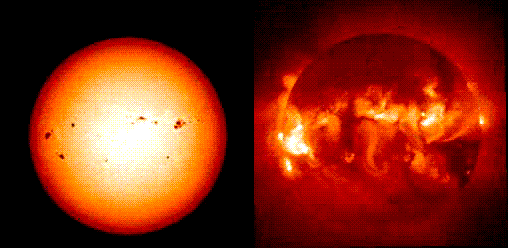
The left hand picture is a normal photograph of the Sun, in visible light. The X-ray photograph on the right from YOHKOH shows the hot corona.

This a montage of two images from SOHO. The inner image of the Sun is taken by the Extreme ultraviolet Imaging Telescope (EIT), which shows plasma at around one million degrees. The outer image is from the UltraViolet Coronagraph and Spectrometer (UVCS) which shows the corona further out. The dark patch running from the solar north pole to the equator is a very large coronal hole, which was called the 'elephants trunk'.
The Transition Region and Coronal Explorer (TRACE) satellite is providing some superb images of the solar atmosphere in the extreme ultraviolet. Amazing images and movies have been obtained of the fine scale structures in the corona.

Images of coronal active region loops obtained by TRACE.
The Sun may appear tranquil but actually it is an incredibly dynamic object with violent explosions spitting out millions of tons of charged particles, called coronal mass ejections (CMEs), towards us at high speeds. These CMEs can impact on the terrestial environment, causing problems with satellites, radio blackouts and disruption to electricity supplies.
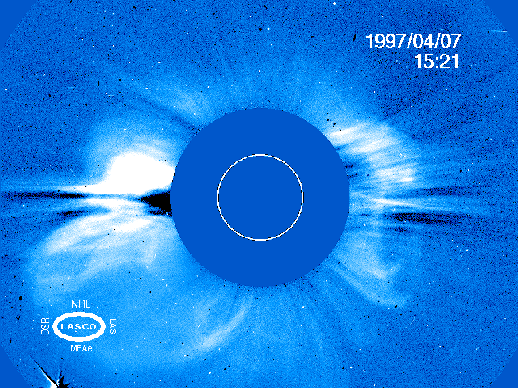
Here is an image taken by the Large Angle Spectroscopic Coronagraph (LASCO) on SOHO, which simulates a total eclipse of the Sun. The white circle shows where the Sun's disk should be (if it were not blocked out).
The Sun has a similar large scale dipole magnetic field to the Earth, but it is much more complicated when you zoom in and look closely. This is because it has lots of little north and south magnetic poles scattered across its surface. These little magnetic poles move about all the time because the solar surface is a bubbling gas.
In the picture below the black blobs are south poles and the white blobs are north poles. The magnetic field is drawn as lines joining the black and white blobs. They form a tangled mess of spaghetti, called the Sun's 'magnetic carpet'. This completely changes every two days.
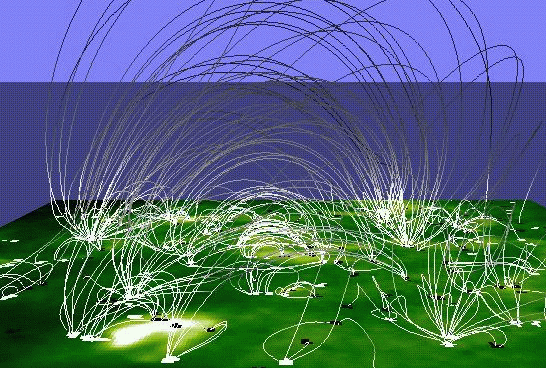
Seismology is the study of earthquakes and is done by measuring the vibrations of the Earth's surface. Helioseismology is a comparatively new field of solar physics whereby vibrations of the Sun's surface are measured (Helios is the Greek word for Sun).
The waves bouncing around inside the Sun cause the surface of the Sun to move up and down by small amounts, a fraction of one km/s. These small motions can be detected by SOHO and we can learn what is happening deep inside the Sun.
Here is a beautiful image showing the differences in the speed of rotation of material in the Sun. The Sun does not rotate like a solid object, but with SOHO we can find out how the Sun is rotating inside.
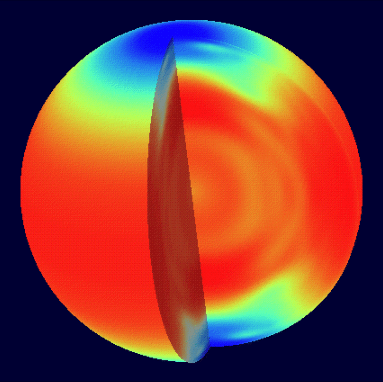
The false colors represent speed; red material is rotating the fastest, dark blue, the slowest. Red material at the Sun's equator is moving approximately three thousand miles per hour faster than the blue material at the poles. The Sun' rotation rate on the surface varies with latitude - from a rotation period of about 25 days near the equator to a rotation period of about 33 days near the poles. this was noted by Glileo who observed the rotation of sunspots. Deeper down inside the Sun, the core rotates like a solid object.
The beauty of the SOHO satellite is that we can monitor the Sun from its deep interior, past its magnetic carpet, through the solar corona and way out into the solar wind. Many different solar features have been studied. We are able to begin to piece together the complex processes which are taking place, the relationship between changes in the Sun's magnetic field, heating and explosions of hot material. It is a fascinating place and we have learnt a lot.